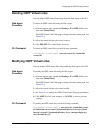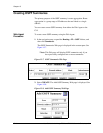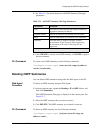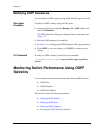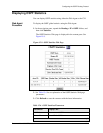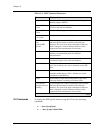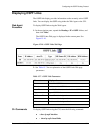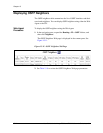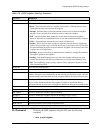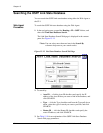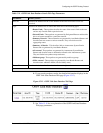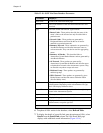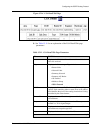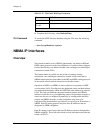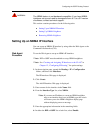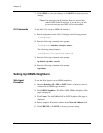
Document No. 10-300077, Issue 2 15-23
Configuring the OSPF Routing Protocol
CLI Command To display the OSPF neighbors using the CLI, enter the following
command:
> show ip ospf neighbor
Table 15-8. OSPF Neighbors Web Page Parameters
Parameter
Definition
IP Address The IP address associated with the OSPF neighbor.
State The functional level of an interface. States include:
• Down - This is the initial state of a neighbor conversation. It indicates that no recent
information has been received from the neighbor.
• Attempt - Indicates that no recent information has been received from the neighbor,
but that a more concerted effort should be made to contact the neighbor
• INIT - Indicates that the Hello packet has recently been seen from the neighbor.
However, bidirectional communication has not yet been established with the neighbor.
• 2-Way - Communication between the two routers is bidirectional.
• ExStart - This is the first step in creating an adjacency between the two neighboring
routers. The goal of this step is to decide which router is the master, and to decide upon
the initial Database Description sequence number. Neighbor conversations in this state
or greater are called adjacencies.
• Exchange - Router is describing its entire link state database by sending DD (Database
Description) packets to the neighbor.
• Loading - Link State Request packets are sent to the neighbor asking for the more
recent LSAs that have been discovered (but not yet received) in the Exchange state.
• Full - The neighboring routers are fully adjacent. These adjacencies appears in router-
LSAs and network-LSAs.
Router ID The router ID of the neighbor.
Master The state of the neighbor: master or slave.
DD Number The hexadecimal number used to sequence the collection of Database Description
Packets. The initial value (indicated by the Init bit being set) should be unique. The DD
sequence number then increments until the complete database description has been sent.
DR Priority Displays the DR Priority of the neighboring router.
This is used to determine whether this neighbor is eligible to become the Backup
Designated Router. If 0, the router is ineligible to become the Backup Designated Router.
E-Option The method used to flood AS-external-LSAs.
T-Option Specifies whether this neighbor is an ASBR.
MC-Option Specifies whether this neighbor supports MOSPF.
N-Option Specifies whether this neighbor supports the handling of Type-7 LSAs.
OPQ-Option Specifies whether this neighbor supports opaque LSAs (LSA type 9-11).
DR Choice Interface IP address of the designated router.
BDR Choice Interface IP address of the backup designated router.



